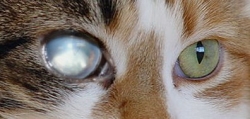Cataracts in cats
One of the more common problems affecting vision, especially with the elderly, is cataracts. This is a gradual clouding over of the lens of the eye which affects vision much as does looking through a dirty or stained window. With humans the problem is generally recognized through an eye exam, and corrected by surgery. However, cats can suffer from cataracts too, and unlike humans, cats canít simply tell others that they are in difficulty. In fact, as cats often do, they might hide the problem so successfully that a cat might virtually be blind before it becomes obvious that something is wrong.
| Cataracts usually start with a small cloudy area on the surface of the eye which then slowly expands to cover the whole lens. However, in some cases when the eye is infected, or a cat has suffered from eye injury, the progression may be much more rapid. As the cataract develops less light reaches the retina and vision becomes more and more impaired. This may eventually lead to complete blindness. A cataract may develop in one or both eyes. Cataracts are normally painless, but they can cause eye inflammation and also further permanent eye damage. |
Symptoms of cataract

If the cataract develops slowly, as many do, the early symptoms will be hard to spot. Most cats adapt well to changes in their vision, and being cats, they seldom show what they consider to be a vulnerability. Luckily most cats have acute other senses, such as smell and hearing, and as a result they can operate comfortably in a familiar environment even when their vision is severely impaired. However, you may note that unexpected changes result in the cat bumping into an unknown object. Also your cat may be unsure of her footing.
A fully-developed cataract can be easily recognised by looking at a cat's eyes. A badly-affected eye will appear to be opaque, but a developing cataract may not be that obvious to an unskilled observer. However, regular visits to the vet will help an early diagnosis, since a check of the eyes is part of a routine veterinary examination.
Another reason for getting a vet's opinion is that nuclear sclerosis is often mistaken for cataracts by non-professionals. As a cat ages so do her eyes. The lens loses a certain amount of water and new fibers form on the lens surface. This results in a bluish haze on the lens which a concerned human might mistake for a developing cataract. However, nuclear sclerosis does not impair the catís vision and it does not need to be treated.
What causes a cataract?
The good news is that cats suffer from cataracts more rarely than humans, with most incidents happening after eye injury or eye infection. Cats suffering from diabetes have an increased risk of developing cataract, but it is not that common.
As with humans, age is certainly a contributing factor. An interesting study on human cataracts showed that with age there is an increase in the breakdown of crystallins; a major protein found in the lens. About 50 percent of the lens is made out of proteins and 90 percent of those are crystallins. The main function of these proteins is to maintain the clarity of the lens. During the lifespan of an individual these proteins break down and replacements are synthesised by the body. As crystallins degrade they break down to peptides which are then cleared from a healthy eye by other proteins. However, with age there is a acceleration of the breakdown of crystallins and these small peptides may not be cleared efficiently.
Whether similar process takes place in the eyes of aged cats has not yet been discovered.
Treatment
A cataract becomes a problem when it impairs vision. The only truly effective treatment is surgery to remove the affected lens and replace it with an artificial one.
Three techniques are in general use for the extraction of an affected lens. With cats phacofragmentation is the preferred method. This uses ultrasonic waves to liquefy the lens, remove any fragments, and moisturize the eye. After the damaged lens has been removed, a new artificial lens can be put in to restore vision.
As mentioned above, cats adapt extremely well to some impairment of vision, so if the cat has a cataract in only one eye, most veterinarians will advise against surgery. However, surgery may be advisable if both eyes are affected and there is a risk of complete blindness. Though no surgery is risk free, surgical treatment for cataracts is normally successful and the prognosis for the cats is excellent.
Before the vet decides to recommend surgery, the catís eye will be examined for any additional damage. Since the most common cause of cataracts in cats is eye injury or infection, the vet needs to ensure that this has caused no additional damage. Otherwise removing the cataract will not solve the problem.
Note: This information is for guidance only. It is not intended to replace consultation with a licensed practitioner.

